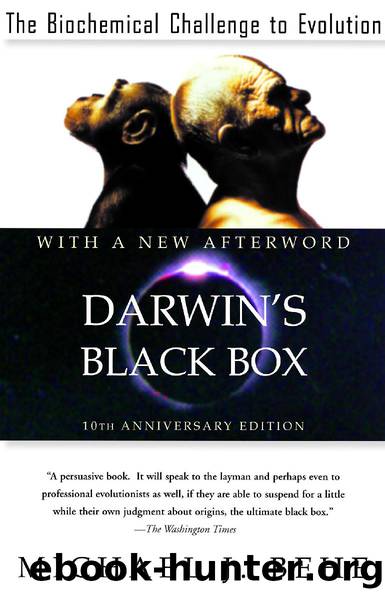Darwin's Black Box by Michael J. Behe

Author:Michael J. Behe
Language: eng
Format: epub
Publisher: Free Press
Published: 2001-04-04T00:00:00+00:00
GETTING THERE
I assume I’ve lost most readers in the labyrinth by now, so let me play accountant and summarize the biosynthesis of AMP. The synthesis takes thirteen steps and involves twelve enzymes; one of the enzymes, IX, catalyzes two steps. Besides the foundation molecule, ribose-5-phosphate, the synthesis requires five molecules of ATP to provide the energy to drive chemical reactions at different steps, one molecule of GTP, one molecule of carbon dioxide, two molecules of glutamine to donate nitrogen atoms at different steps, a molecule of glycine, two formyl groups from THF at separate steps, and two molecules of aspartic acid to donate nitrogen atoms at another two steps. Additionally, at two separate steps the remains of aspartic acid molecules have to be cut off, and at two separate steps parts of the growing molecule have to be reacted with each other to close the two rings. All thirteen steps occur to produce just one kind of molecule. The precursor molecules along the synthetic pathway—Intermediates III to XI—play no independent role; they are used for nothing but to make AMP or GMP.
All roads lead to Rome, it is said, and similarly there are many ways to synthesize AMP. A book for chemists that I have on my shelf lists eight different ways to make adenine (which is the top part of AMP, without the foundation); 5the remainder of the molecule can be put together in a variety of ways also. Chemists who want to synthesize adenine, however, use completely different routes from that used by cells. Because they involve reactions in oily liquids at extremes of acidity, these conditions would cause the quick demise of any known organism.
In the early 1960s scientists who were interested in the origin of life discovered an interesting way to synthesize adenine. 6They saw that the simple molecules hydrogen cyanide and ammonia—which are thought to have been plentiful in the early days of earth—will form adenine under the right conditions. The ease of the reaction so impressed Stanley Miller that he called it “the rock of the faith” for origin-of-life researchers. 7But there’s a problem lurking in the background: hydrogen cyanide and ammonia are not used in the biosynthesis of AMP. But even if they were on the ancient earth, and even if that had something to do with the origin of life (which is problematic on a number of other grounds), the synthesis of adenine from simple molecules in a chemist’s flask gives us absolutely no information about how the route for making the molecule first developed in the cell.
Stanley Miller was impressed by the ease of synthesis of adenine from simple molecules, but the cell eschews simple synthesis. In fact, if we dissolved in water (using the formal chemical names) ribose-5-phosphate, glutamine, aspartic acid, glycine, N10 -formyl-THF, carbon dioxide, and energy packets of ATP and GTP—all the small molecules that are used by the cell to build AMP—and let them sit for a long time (say, a thousand or a million years) we would not get any AMP.
Download
This site does not store any files on its server. We only index and link to content provided by other sites. Please contact the content providers to delete copyright contents if any and email us, we'll remove relevant links or contents immediately.
| Cell Biology | Developmental Biology |
| Entomology | Marine Biology |
| Microbiology | Molecular Biology |
| Biostatistics |
Sapiens: A Brief History of Humankind by Yuval Noah Harari(13053)
The Tidewater Tales by John Barth(12030)
Do No Harm Stories of Life, Death and Brain Surgery by Henry Marsh(6336)
Mastermind: How to Think Like Sherlock Holmes by Maria Konnikova(6236)
The Thirst by Nesbo Jo(5785)
Why We Sleep: Unlocking the Power of Sleep and Dreams by Matthew Walker(5642)
Sapiens by Yuval Noah Harari(4537)
Life 3.0: Being Human in the Age of Artificial Intelligence by Tegmark Max(4508)
The Longevity Diet by Valter Longo(4445)
The Rules Do Not Apply by Ariel Levy(3906)
The Immortal Life of Henrietta Lacks by Rebecca Skloot(3826)
The Body: A Guide for Occupants by Bill Bryson(3802)
Why We Sleep by Matthew Walker(3773)
Animal Frequency by Melissa Alvarez(3755)
Yoga Anatomy by Kaminoff Leslie(3701)
Barron's AP Biology by Goldberg M.S. Deborah T(3632)
The Hacking of the American Mind by Robert H. Lustig(3580)
All Creatures Great and Small by James Herriot(3516)
Yoga Anatomy by Leslie Kaminoff & Amy Matthews(3396)
